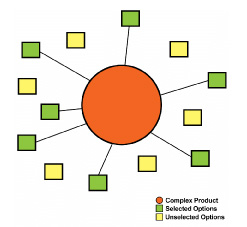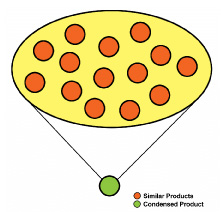
Prime
Time for Complex Products The most fertile E-Commerce territory has been long staked out and farmed and nowhere is this more apparent than in the retail market for books, DVD's and other relatively simple products. Indeed, early success stories on the Internet were oriented around the sale of simple products those whose brick-and-mortar purchasing processes could be most easily transferred into an Internet-based environment. Consumers accustomed to the pick-and-pay experience of the conventional retail store quickly adapted to the shopping cart metaphor of early E-Commerce sites. That metaphor has come to dominate the themes of E-Commerce best practices. Complex Products Unable to make effective use of off-the-shelf E-Commerce solutions, many merchants selling complex products developed their own in-house solutions, some with great success. And innovative tools continue to be developed by forward-thinking merchants who want to find better ways to sell complex products. Now that the market for simple products has been fully developed, the best growth opportunities for selling online may well lie in the developing world of complex products. Companies that can figure out how to effectively sell complex products can gain a significant market edge over competitors. The differentiation between simple and complex products is somewhat fuzzy, and there are several competing definitions for what makes a product complex. Generally speaking, however, a simple product is one that typically has 1) few variations and 2) simple pricing. Examples include books, shoes, hats, DVD's and the majority of consumer products. Complex products are defined by 1) many variations and 2) complex pricing. In the industrial marketplace, it is common for one type of product to have hundreds of slight variations, and for merchants to offer volume pricing. An ordinary bolt, for example, may have variations in diameter, length, head type, thread type, metal type, etc. The same bolt may have four columns of volume pricing, offering preferential pricing for customers who order in large quantities. Furthermore, complex products often have pricing that is calculated per bulk measure rather than per piece, as is the case for cable sold by the linear foot, or steel sheet sold by the square meter. These types of variation and pricing complexities make it difficult for merchants, especially smallto- mid-sized merchants, to effectively sell these types of products online. There are two classes of tools that have emerged independently among online merchants, both of which have broad applications in the sale of complex products. Often confused with one another, product configurators and product condensers both simplify the presentation and selection of complex products, but in different ways. Product Configurators One of the earliest configurators was Dell's E-Commerce site which allowed customers to select desired options and, in effect, build their own computer online. Because the selection of one piece of hardware might preclude the selection of another, the configurator needed to recognize the relationship between the various options. Configurators allow merchants to offer highly customized products in a way that cannot be accomplished by off-the-shelf E-Commerce software. In fact, merchants often build configurators for a single type product, specifically tailored for the characteristics of that product. Configurators for Product Discovery Some merchants use configurators as product navigators, fulfilling the role of an offline sales consultant in which the customer specifies general requirements, and a list of products meeting those requirements is presented. A customer using a configurator to find a suitable type of industrial hose, for example, could specify certain characteristics such as diameter, operating environment and application; the configurator would then present the full range of perhaps a dozen or so suitable products based upon the configurator entries. Configurators for Product Quotation Product Condensers Reducing the Clutter Take the case of a merchant selling various types of bolts, for example. Their web site may list hundreds of different styles of bolts, each of which also has slight variations in diameter, head type, thread type, length, etc. In a traditional paper-based catalog, each of the slight variations would typically be listed as a separate row in a large table. However, using a product condenser on a web page allows all of the related SKU's to be 'squeezed' into a single object that appears on the web page. In short, many products are condensed into a single product. In order to purchase the product, the customer is first directed to select a diameter, which triggers the display of available lengths. Selecting one of the lengths triggers the display of available head types, and so on. When the customer has selected all required variations, the product's 'Buy Now' button becomes visible, making the product available for purchase. Also, the specific SKU and pricing for the selected variations is displayed. All of this occurs in real-time, driven by embedded code within the web page itself. There are no server requests, thus, no delays in the product selection process. Unit Measures and Interdependencies In the marketplace for E-Commerce tools, the development of product configurators is somewhat ahead of product condensers, and there continues to be some overlap in how each is best applied in actual practice. When faced with the need to simplify the presentation of complex products, eBusiness managers should consider whether they are dealing with 1) a single product with lots of options or 2) many products that are highly similar. A product configurator is best applied to a single product with many options, while a product condenser is best applied to a group of highly related products. New Opportunities Author note List of Figures
Figure 1 - Product Configurator Figure 2 - Product Condenser |
|

